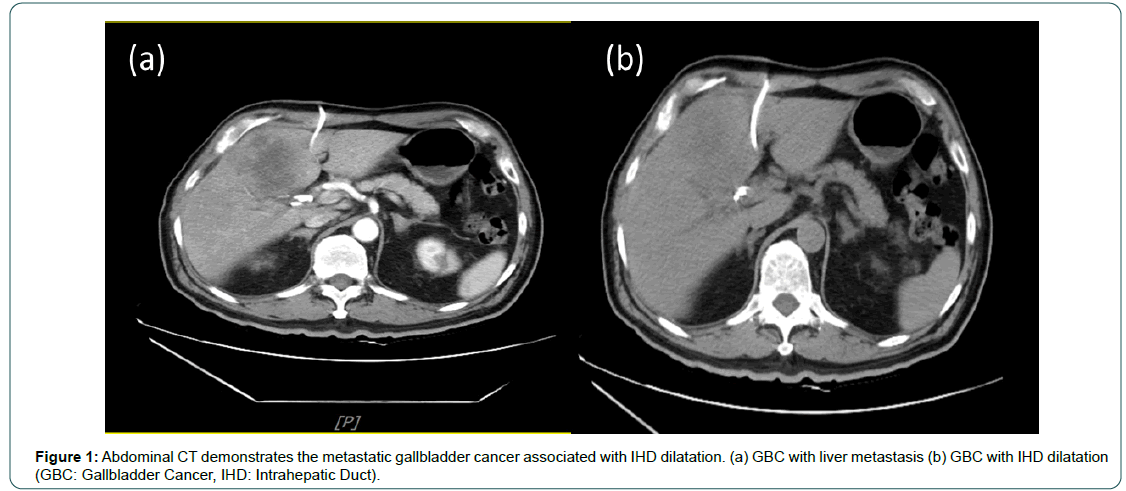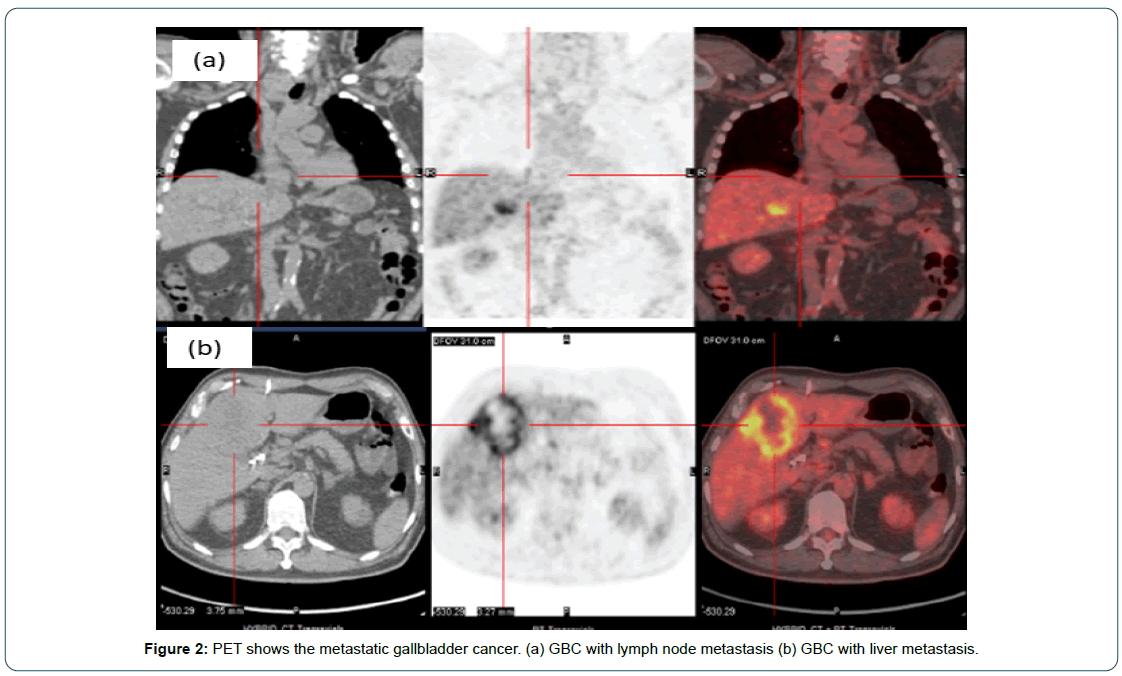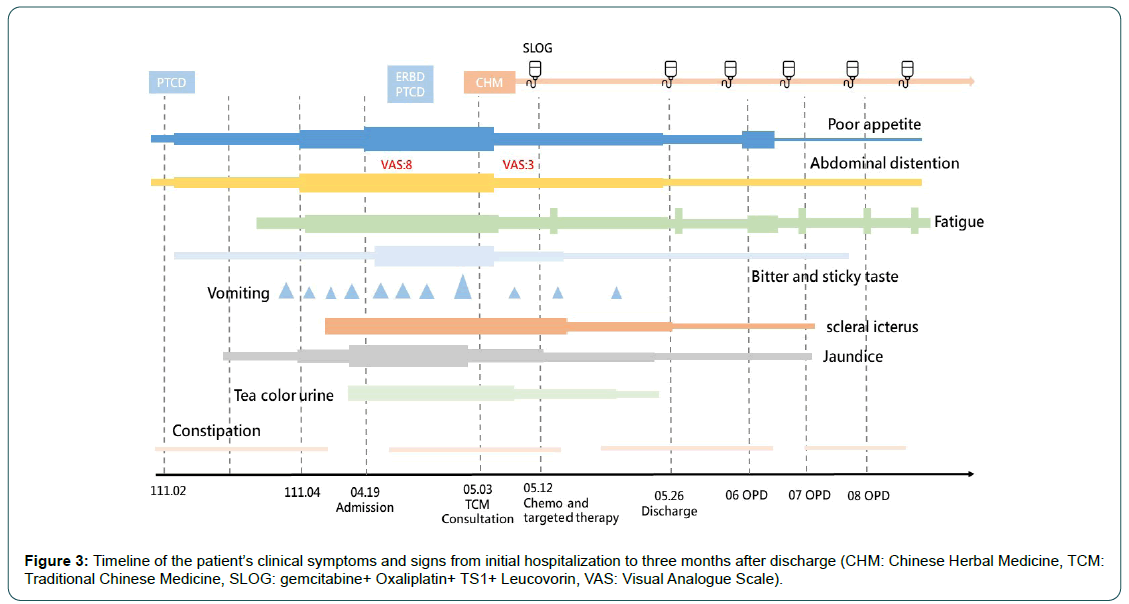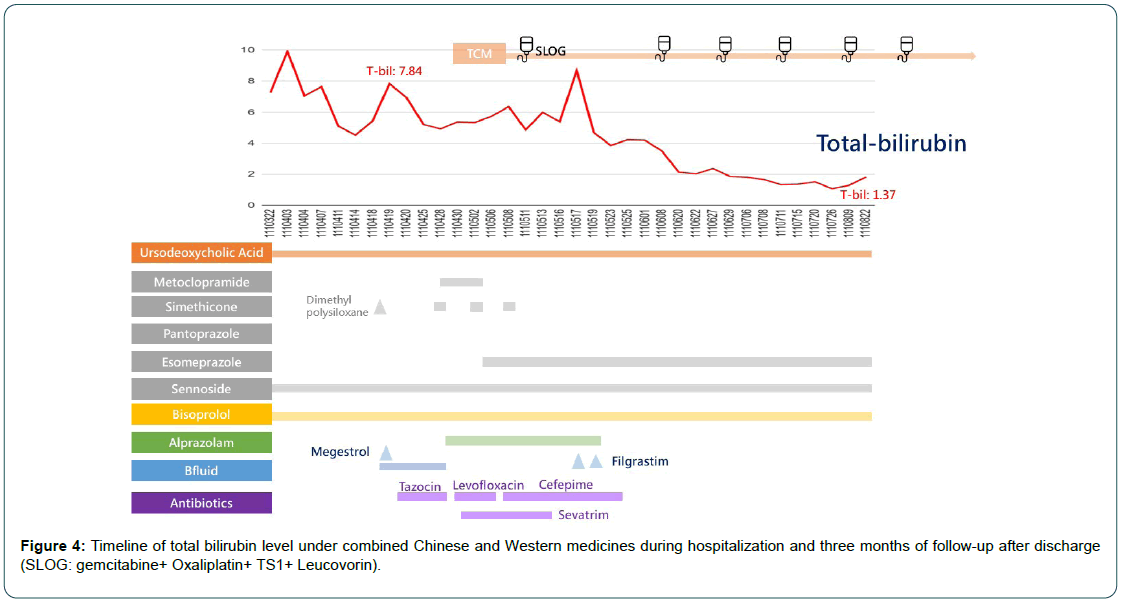Case Report, Clin Oncol Case Rep Vol: 6 Issue: 3
Chinese Herbal Medicine Integrated with Western Medicine Significantly Ameliorated Hyperbilirubinemia in a Patient with Metastatic Gallbladder Adenocarcinoma: A Case Report
Shng-Tng Hung1,2,3,4*, Da-Yng Lin1
1Department of Chinese Medicine, China Medical University Hospital, Taichung, Taiwan
2School of Chinese Medicine, China Medical University, Taichung, Taiwan
3Research Cancer Center for Traditional Chinese Medicine, Department of Medical Research, China Medical University Hospital, Taichung, Taiwan
4An-Nan Hospital, China Medical University, Tainan, Taiwan
*Corresponding Author: Sheng-Teng Huang
Department of Chinese Medicine
China Medical University Hospital, No. 2, Yude Rd, North District, Taichung 40447, Taiwan.
E-mail: d982@mail.cmuh.org.tw
Received: February 25, 2023; Manuscript No: COCR-23-90147;
Editor Assigned: February 27, 2023; PreQC Id: COCR-23-90147 (PQ);
Reviewed: March 10, 2023; QC No: COCR-23-90147 (Q);
Revised: March 13, 2023; Manuscript No: COCR-23-90147 (R);
Published: March 17, 2023; DOI: 10.4172/cocr.6(3).279
Citation: Huang S, Lin DY (2023) Chinese Herbal Medicine Integrated with Western Medicine Significantly Ameliorated Hyperbilirubinemia in a Patient with Metastatic Gallbladder Adenocarcinoma: A Case Report. Clin Oncol Case Rep 6:3
Abstract
Case: This is the case of a patient with metastatic gallbladder adenocarcinoma complicated by cholestasis and hyperbilirubinemia. Initial Western medical treatment and percutaneous transhepatic cholangial drainage achieved limited improvement in his clinical condition.
Clinical features and outcome: In March 2022, the 68-year-old male with no family history of cancer was diagnosed with clinical stage M1 gallbladder adenocarcinoma associated with liver and distant lymph node metastasis. During hospitalization, symptoms including scleral icterus, jaundice, fatigue, poor appetite, vomiting, abdominal distention, constipation, tea-colored urine, and decreased body weight were noted. The initial total bilirubin level measured at 7.84 mg/dL. The traditional Chinese medicine department was consulted on day 14 of admission. After integrating Chinese herbal medical treatment, the patient’s clinical symptoms gradually improved, including the cholestasis. The patient was discharged on day 36. The patient subsequently received regular Western and Chinese medical treatments; while his total bilirubin level decreased to 1.37 mg/dL, maintaining a level under 2.0 mg/dL three months after being discharged.
Conclusion: During the 36 days of hospitalization and the post-discharge follow-up period, integrated Chinese and Western therapies improved the hyperbilirubinemia and quality of life in this patient with metastatic gallbladder cancer.
Keywords: Traditional chinese medicine; Gallbladder cancer; Cholestasis; Hyperbilirubinemia
Abbreviation
AKI: Acute Kidney Injury; ALP: Alkaline Phosphatase; ALT: Alanine Transaminase; AST: Alanine Aminotransferase; BTI: Biliary Tract Infection; CMUH: China Medical University Hospital; Cre: Creatinine; CT: Computed Tomography; DCHT: Da Chai Hu Tang; ECOG: Eastern Cooperative Oncology Group; ERCP: Endoscopic Retrograde Cholangio-Pancreatography; GBC: Gallbladder Cancer; IHD: Intrahepatic Duct; PET: Positron Emission Tomography; PTCD: Percutaneous Transhepatic Cholangiography and Drainage; rGT: r-Glutamyl Transferase; T-bil: Total-Bilirubin; VAS: Visual Analogue Scale; WBC: White Blood Cell; YCHT: Yin Chen Hao Tang.
Introduction
Gallbladder Cancer (GBC) is a relatively uncommon but aggressive malignancy. GBC is characterized by its high fatality rate due to its asymptomatic nature in the early stages, further associated with rapid progression and thus often diagnosed in the late or advanced stages [1]. The median survival time for patients with GBC is less than one year, while the average 5-year survival rate is less than 5% [2, 3].
GBC has a higher prevalence in females and is more common in those of Caucasian and Southwestern Native American descent [4]. Chronic inflammation induced by gallbladder stones (cholelithiasis) and gallbladder infections are among the most critical risk factors for GBC [4]. Meanwhile, abdominal pain, jaundice, and unexplained weight loss are warning signs and symptoms for GBC [5].
Currently, the most effective treatment modality for GBC is surgery. However, patients with late-stage GBC or with metastasis are not ideal candidates for surgery. In patients presenting with advanced GBC, chemotherapy, radiotherapy, and palliative care are the most common treatment options. Unfortunately, the one-year survival rate for advanced GBC under radiotherapy or chemotherapy remains relatively low [5].
Herein, we report on a hospitalized patient diagnosed with gallbladder adenocarcinoma associated with liver and lymph node metastasis. Initial Western medical treatment, including Percutaneous Transhepatic Cholangiography and Drainage (PTCD), ursodeoxycholic acid, sennosides, and antibiotics achieved limited clinical effectiveness. The subsequent integration of Chinese herbal medicine acted to relieve symptoms including nausea, vomiting, abdominal distention, and jaundice. During the 36 days of hospitalization and the post-discharge follow-up period, the integration of Chinese and Western medical treatments significantly alleviated the hyperbilirubinemia and improved the patient’s quality of life.
Case Presentation
Case
The initial diagnostic interview revealed that the patient was a 68-year-old male (body mass index:19.7) whose occupation was an architect, and who had lived in Vietnam for the prior 10 years. He did not smoke, although occasionally consumed alcohol. The patient had a history of hypertension with no family history of cancer. He was diagnosed with clinical stage M1 gallbladder adenocarcinoma with liver and distant lymph node metastasis at China Medical University Hospital (CMUH) in March of 2022. The Computed Tomography (CT) (Figure 1a and 1b) and Positron Emission Tomography (PET)(Figure 2a and 2b) examinations revealed a gallbladder tumor with liver invasion to the Intrahepatic Duct (IHD) with IHD dilatation and lymph node metastasis. The pathology report revealed the cancer markers CK7 (+), CK20 (-), TTF-1 (scattered), and CDX-2 (+, focal) in the adenocarcinoma of gallbladder origin.
Due to the abdominal distention associated with severe nausea and vomiting, the patient received PTCD which resulted in dark brown drainage of 300 cc/day to 400 cc/day, for which he was administered ursodeoxycholic acid and sennosides for symptom relief. The patient was admitted with a diagnosis of Biliary Tract Infection (BTI) and Acute Kidney Injury (AKI) on April 19th, 2022. The laboratory data exhibited the following results: White Blood Cell (WBC) 14700 /ul with neutrophil predominant (88.3%); totalbilirubin (T-bil): 7.84 mg/dL; Alanine Transaminase (ALT): 65 U/L; Aspartate Aminotransferase (AST): 55 U/L; alkaline phosphatase (ALP): 865 U/L; r-Glutamyl Transferase (rGT): 1803 U/L; Amylase: 140 U/L; Lipase: 224U/L; Creatinine (Cre): 2.74mg/dL; GFR: 23mL/min/1.73m2 ; and Hyperkalemia (K: 5.5 mmol/L). The bile culture revealed both stenotrophomonas and staphylococcus infections. Under empirical antibiotic treatments (Tazocin initially, then Levofloxacin and Sevatrim), hydration and Endoscopic Retrograde Cholangio-Pancreatography (ERCP) with Endoscopic Retrograde Biliary Drainage (ERBD), the patient’s condition gradually stabilized (WBC: 9000, T-bil: 4.93, Cre: 0.53). However, intermittent vomiting and jaundice persisted, prompting the patient to consult the Traditional Chinese Medicine (TCM) department for integrated treatment on May 3rd, 2022.
Treatment and intervention
On day 14 of hospitalization, the patient’s symptoms included scleral icterus, jaundice, dyspnea, fatigue, a bitter and sticky oral sensation, poor appetite, vomiting, abdominal distention, constipation, tea-colored urine, insomnia, and decreased body weight. The tongue inspection revealed a red, skinny body with mild tooth marks, stasis on the tip of the tongue, and a slimy, heavy, yellowish fur at the base. The wrist pulse revealed an overall slippery diagnosis, while the abdominal examination indicated tympanic, with middle and right-upper-quarter tenderness.
Based on the initial examination and diagnosis by the TCM physician, Chinese Herbal Medicine (CHM) treatment was prescribed which consisted of Da-Chai-Hu-Tang, Yin-Chen-Hao-Tang, and several herbs for nourishment. This particular prescription was composed of Panax quinquefolius 3.0, Astragalus membranaceus 3.0, Salviae miltiorrhizae 3.0, Ophiopogon japonicas 3.0, Citri reticulatae 3.0, Artemisiae scopariae 3.0, Curcuma aromatic 3.0, Magnolia officinalis 3.0, Aurantii fructus 3.0, Pinelliae rhizoma 3.0, Rheum rhabarbarum 2.5, Paeonia lactiflora 3.0, Bupleuri radix 2.5, Scutellaria baicalensis Georgi 2.5, and Glycyrrhiza uralensis 2.0 (qian). The above herbal constituents were decocted with water and concentrated into 120 cc packs, to be consumed three times per day.
The patient’s clinical symptoms gradually improved upon CHM combined with Western medical treatment. The jaundice, scleral icterus, and the heavy yellowish fur on the surface of the tongue were ameliorated. Meanwhile, a Visual Analogue Scale (VAS) was applied to measure the abdominal tenderness, which decreased from a score of 8 to 3 after taking CHM. The patient’s subjective rating regarding quality of life and mood also improved due to decreased nausea, reduced bitter taste in the mouth, regularized defecation of 1 times to 3 times per day, and increased appetite (Figure 3).
The patient’s physical condition improved to the point where on day 23 he received the first session of chemotherapy and targeted therapy with SLOG (gemcitabine+ Oxaliplatin+ TS1+ Leucovorin) plus Nivolumab. After a total of 36 days of hospitalization, the patient was discharged on May 25th, 2022 in a relatively stable condition, with a decreased total bilirubin level of 4.23 mg/dL.
After discharge, the patient received both chemotherapy and target therapy combined with CHM treatment on a regular basis. The patient could manage his daily life with familial assistance and could walk independently without need of an assistive device. The Eastern Cooperative Oncology Group (ECOG) performance status was estimated at 2, indicating the patient was capable of all self-care but unable to carry out any work activities, and could remain active for approximately >50% of waking hours. Additionally, his total bilirubin level had decreased to 1.37 mg/dL and maintained a level of <2.0 mg/ dL at three months after being discharged (Figure 4), accompanied by a decreased ALT level (from 12213 U/L to 13 U/L), AST level (from 7713 U/L to 26 U/L ) and r-GT level (from 180313 U/L to 435 U/L).
Discussion
This is the case report of a 68-year-old male with gallbladder adenocarcinoma with liver and lymph node metastasis. He suffered from hyperbilirubinemia, severe vomiting and abdominal discomfort during hospitalization. According to a previous report, jaundice is a poor indicator for GBC as it is related to tumor infiltration [6]. Meanwhile, the effectiveness of treatment modalities for patients with advanced GBC remains limited [7].
Based on TCM theory and the diagnostic assessment, the patient was classified as presenting with a dampness-heat pattern originating from the counterflow of gallbladder and stomach qi. Therefore, the TCM prescription aimed to clear the heat and drain the dampness, as well as harmonize the counterflow, soothe the liver and tonify the patient’s yin.
The specific CHM treatment prescribed for the patient in this case consisted of various herbs and herbal formulas. Yin Chen Hao Tang (YCHT), composed of Artemisiae Scopariae, Rheum rhabarbarum and Gardenia jasminoides, acts to clear heat and dampness, promote diuresis and remove jaundice, thereby playing a crucial role in the treatment of liver disease [8]. A meta-analysis cohort study reported that YCHT can improve cholestasis and downregulate serum T-bil, AST and ALT levels [9]. In addition, an in vivo study revealed that YCHT exhibits hepatoprotective effects by inhibiting oxidative stress [10], and prevents biliary cirrhosis by inhibiting biliary epithelial cell proliferation [11]. Furthermore, a study involving a rat model demonstrated that the combination of ursodeoxycholic acid and YCHT treatment significantly improved cholestasis.
Da Chai Hu Tang (DCHT), composed of Bupleurum falcatum, Scutellaria baicalensis, Pinellia ternate, Paeonia lactiflora, Rheum palmatum, Citrus aurantium, Zingiber officinale and Ziziphus jujube, has been applied in the treatment of liver and gallbladder diseases for many years. Previous studies have reported that DCHT can regulate bile acid synthesis and excretion to improve cholestasis [12, 13].
Artemisiae Scopariae (Yin Chen) is commonly prescribed for cholestatic liver disease [14], the major components of which are scoparone and capillarisin. The pharmaceutical effects of sc oparone include hepato-protection and anti-cholestasis [15]. Similarly, capillarisin exerts anti-cholestasis and anti-cancer effects.
Rheum rhabarbarum is an important CHM and is applied in the treatment of a wide variety of diseases. The m ost critical c ompound found in Rheum rhabarbarum is rhein, which has been reported to inhibit cancer cell proliferation [16]. Additionally, a study by Liu et al. reported that prescriptions composed of Rheum rhabarbarum inhibited the proliferation of breast cancer cells both in vitro and in vivo [17]. Furthermore, it has been shown that the combination of rhein and Western medicine can successfully inhibit gastric cancer growth via regulation of the PI3K/AKT/mTOR pathway [18].
Salviae miltiorrhizae is another significant CHM, providing effects which include enhanced blood circulation and the clearing of blood stasis. Recent research indicates that Salviae miltiorrhizae has anti-inflammatory, anticoagulant, antithrombotic and anti-tumor effects [19]; thus, it is used to treat a wide variety of diseases [20]. In a study of rats with hepatocarcinoma, it was reported that Salviae miltiorrhizae acts to ameliorate obstructive jaundice and inhibit proliferation and metastasis [11].
Baicalin, the major ingredient of Scutellaria baicalensis, can improve cholestasis by mediating oxidative stress- and inflammationrelated pathways [21]. In addition. baicalin has been shown to regulate bile acid metabolism and inhibit the progression of hepatocellular carcinoma through immune regulation [22]. Meanwhile, an in vitro study reported that compounds present in Paeonia lactiflora act to alleviate cholestasis and downregulate the total bilirubin level [23-25]. The specific herbs prescribed for the patient in this case report are shown in (Table 1), including their composition and the possible mechanisms involved in the treatment.
Table 1: Compositions and functions of the Chinese herbal medicine prescribed in this case.
| Chinese Herbal Medicine | Compositions | Functions |
|---|---|---|
| Yin Chen Hao Tang | Artemisiae scopariae | Improve the cholestasis |
| Rheum rhabarbarum | Downregulate T-bil, AST and ALT level | |
| Gardenia jasminoides | Hepatoprotective effect Prevention of biliary cirrhosis | |
| Da Chai Hu Tang | Bupleurum falcatum, Scutellaria baicalensis, Pinellia ternate, Paeonia lactiflora, Rheum palmatum, Citrus aurantium, Zingiber officinale, Ziziphus jujube | Improve the cholestasis |
| Regulate bile acid synthesis and exertion | ||
| Artemisiae scopariae | - | Hepatoprotective effect |
| Anti-cholestasis effect | ||
| Anti-cancer effect | ||
| Rheum rhabarbarum | - | Inhibit cancer proliferation |
| Inhibit cancer growth | ||
| Salviae Miltiorrhizae | - | Improve the obstructive jaundice |
| Inhibit hepatocarcinoma proliferation and metastasis | ||
| Scutellaria baicalensis | - | Improve cholestasis |
| Regulate the bile acid metabolism | ||
| Inhibit the progression of hepatocellular carcinoma | ||
| Paeonia lactiflora | - | Improve the cholestasis |
| Downregulate the total bilirubin level |
Conclusion
Collectively, this case of a male patient with metastatic gallbladder cancer demonstrates that integrated Chinese and Western therapies acted to ameliorate the hyperbilirubinemia and enhance the patient’s quality of life. It is however necessary to note that long-term followup and further investigation of the specific m echanisms i nvolved i n the treatment would provide valuable insight into the benefits of such integrated therapy
Acknowledgements
The authors would like to thank James Waddell for the critical reading and revision of our manuscript.
Author Contributions
Conceptualization: Dai-Ying Lin, Sheng-Teng Huang
Data curation: Dai-Ying Lin, Sheng-Teng Huang
Formal analysis: Dai-Ying Lin
Investigation: Dai-Ying Lin
Supervision: Sheng-Teng Huang
Writing-original draft: Dai-Ying Lin
Writing-review & editing: Sheng-Teng Huang.
Conficts of interests
None declared.
Funding
This work was supported and funded by the Ministry of Science and Technology of Taiwan [NSTC111-2320-B-039-025-] and China Medical University Hospital [DMR-110-189, DMR-111-005, DMR-111-013, DMR-111-016, and DMR-111-195].
Ethics Statement
We obtained written informed consent from the patient for scientific purposes. This study was approved by the Institutional Review Board of China Medical University Hospital (CMUH112-REC-003).
Data Availability Statement
The datasets generated for this study are available on request to the corresponding authors.
References
- Perpetuo MD, Valdivieso M, Heilbrun LK, Nelson RS, Connor T, et al. (1978) Natural history study of gallbladder cancer: A review of 36 years experience at M. D. Anderson Hospital and Tumor Institute. Cancer 42: 330-335. [Google Scholar] [Cross Ref]
- Hundal R, Shaffer EA (2014) Gallbladder cancer: Epidemiology and outcome. Clin Epidemiol 6: 99-109. [Google Scholar] [Cross Ref]
- Akhtar-Danesh N, Akhtar-Danseh GG, Seow H, Shakeel S, Finley C (2021) Treatment modality and trends in survival for gallbladder cancer: A population-based study. J Gastrointest Cancer 52: 256-262. [Google Scholar] [Cross Ref]
- Mukkamalla SKR, Kashyap S, Recio-Boiles A, Recio-Boiles A, Babiker HM (2022) Gallbladder cancer. Treas Island: StatPearls. [Google Scholar] [Cross Ref]
- Roa I, Araya JC, Villaseca M, De Aretxabala X, Riedemann P, et al. (1996) Preneoplastic lesions and gallbladder cancer: An estimate of the period required for progression. Gastroenterology 111: 232-236. [Google Scholar] [Cross Ref]
- Shukla SK, Singh G, Shahi KS, Bhuvan, Pant P (2018) Staging, treatment, and future approaches of gallbladder carcinoma. J Gastrointest Cancer 49: 9-15. [Google Scholar] [Cross Ref]
- Tran TB, Norton JA, Ethun CG, Pawlik TM, Buettner S, et al.(2017) Gallbladder cancer presenting with jaundice: Uniformly fatal or still potentially curable? J Gastrointest Surg 21: 1245-1253. [Google Scholar] [Cross Ref]
- Azizi AA, Lamarca A, McNamara MG, Valle JW (2021) Chemotherapy for advanced gallbladder cancer (GBC): A systematic review and meta-analysis. Crit Rev Oncol Hematol 163: 103328. [Google Scholar] [Cross Ref]
- Li JY, Cao HY, Sun L, Sun RF, Wu C, et al. (2017) Therapeutic mechanism of Yīn-Chén-Hāo decoction in hepatic diseases. World J Gastroenterol 23: 1125-1138. [Google Scholar] [Cross Ref]
- Chen Z, Ma X, Zhao Y, Wang J, Zhang Y, et al. (2015) Yinchenhao decoction in the treatment of cholestasis: A systematic review and meta-analysis. J Ethnopharmacol 168: 208-216. [Google Scholar] [Cross Ref]
- Lee TY, Chang HH, Chen JH, Hsueh ML, Kuo JJ (2007) Herb medicine Yin-Chen-Hao-Tang ameliorates hepatic fibrosis in bile duct ligation rats. J Ethnopharmacol 109: 318-324. [Google Scholar] [Cross Ref]
- Wang B, Sun MY, Long AH, Cao HY, Ren S, et al. (2015) Yin-Chen-Hao-Tang alleviates biliary obstructive cirrhosis in rats by inhibiting biliary epithelial cell proliferation and activation. Pharmacogn Mag 11: 417-425. [Google Scholar] [Cross Ref]
- Nomura M, Hida T, Miyamoto K-i, Ohshima T, Hayashi H, et al. (1995) Synergistic effects of Inchin-ko-to (Yin-Chen-Hao-Tang) and ursodeoxycholic acid on cholestasis caused by α-naphthyl isothiocyanate. Phytother Res 9: 563-566. [Google Scholar] [Cross Ref]
- Zhou Y, Zhou Y, Li Y, Sun W, Wang Z, et al. (2022) Targeted bile acid profiles reveal the liver injury amelioration of Da-Chai-Hu decoction against ANIT- and BDL-induced cholestasis. Front Pharmacol 13: 959074. [Google Scholar] [Cross Ref]
- Xu S, Qiao X, Peng P, Zhu Z, Li Y, et al. (2022) Da-Chai-Hu-Tang protects from acute intrahepatic cholestasis by inhibiting hepatic inflammation and bile accumulation via activation of pparα. Front Pharmacol 13: 847483. [Google Scholar] [Cross Ref]
- Cai Y, Zheng Q, Sun R, Wu J, Li X, et al. (2020) Recent progress in the study of Artemisiae Scopariae Herba (Yin Chen), a promising medicinal herb for liver diseases. Biomed Pharmacother 130: 110513. [Google Scholar] [Cross Ref]
- Zhang A, Sun H, Dou S, Sun W, Wu X, et al. (2013) Metabolomics study on the hepatoprotective effect of scoparone using ultra-performance liquid chromatography/electrospray ionization quadruple time-of-flight mass spectrometry. Analyst 138: 353-361. [Google Scholar] [Cross Ref]
- Khan MS, Mehmood B, Yousafi Q, Bibi S, Fazal S, et al.(2021) Molecular docking studies reveal rhein from rhubarb (Rheum rhabarbarum) as a putative inhibitor of atp-binding cassette super-family G member 2. Med Chem 17: 273-288. [Google Scholar] [Cross Ref]
- Liu YT, Hsiao CH, Tzang BS, Hsu TC (2019) In vitro and in vivo effects of traditional Chinese medicine formula T33 in human breast cancer cells. BMC Complement Altern Med 19: 211. [Google Scholar] [Cross Ref]
- Gao F, Li R, Wei PF, Ou L, Li M, et al.(2022) Synergistic anticancer effects of everolimus (RAD001) and Rhein on gastric cancer cells via phosphoinositide-3-kinase (PI3K)/protein kinase B (AKT)/mammalian target of rapamycin (mTOR) pathway. Bioengineered 13: 6332-6342. [Google Scholar] [Cross Ref]
- Zhang Y, Guo S, Fang J, Peng B, Zhang Y, et al. (2018) Tanshinone IIA inhibits cell proliferation and tumor growth by downregulating STAT3 in human gastric cancer. Exp Ther Med 16: 2931-2937. [Google Scholar] [Cross Ref]
- Guo R, Li L, Su J, Li S, Duncan SE, et al.(2020) Pharmacological activity and mechanism of tanshinone iia in related diseases. Drug Des Devel Ther 14: 4735-4748. [Google Scholar] [Cross Ref]
- Yang JY, Li M, Zhang CL, Liu D (2021) Pharmacological properties of baicalin on liver diseases: A narrative review. Pharmacol Rep 73: 1230-1239. [Google Scholar] [Cross Ref]
- Hu Q, Zhang W, Wu Z, Tian X, Xiang J, et al.(2021) Baicalin and the liver-gut system: Pharmacological bases explaining its therapeutic effects. Pharmacol Res 165: 105444. [Google Scholar] [Cross Ref]
- Ma X, Zhao YL, Zhu Y, Chen Z, Wang JB, et al.(2015) Paeonia lactiflora Pall. protects against ANIT-induced cholestasis by activating Nrf2 via PI3K/Akt signaling pathway. Drug Des Devel Ther 9: 5061-5074. [Google Scholar] [Cross Ref]
 Spanish
Spanish  Chinese
Chinese  Russian
Russian  German
German  French
French  Japanese
Japanese  Portuguese
Portuguese  Hindi
Hindi 



